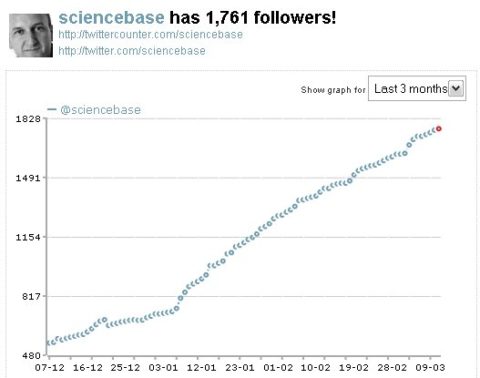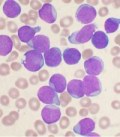I carried out a little ad hoc experiment in social media this week. Having backed up my twitter friends and followers using Tweetake, I figured it was time to make them earn their keep…I jest. No, seriously, I’d downloaded the lists, which come as CSV files you can open in a spreadsheet program, and just for fun I thought I’d sort them into groups, picking science-related tweeps as the first category. By, pure chance, there were 100 scientific twitter users in that list.
Next, step was to cut and paste this list into my blog software and activate the web addresses for these 100 scientific tweeters. I then, of course, posted a tweet to let everyone know I’d compiled a list of twitter users with a scientific bent. Several people retweeted my tweet and I started to get some nice responses, direct messages, blog comments, and emails. Some of these came from twitter friends who had been inadvertently left off the list, so I added them and also activated their twitter name in the list, making it linkable to their twitter profile.
That move then formed the basis of a nice trade – you retweet or comment on the list and I’ll add you if you’re aren’t already on it and if you are I’d activate your twitter name and so it grows. I’ve not counted how many times it has now been mentioned, suffice to say that my local twitterhood continues to grow. Moreover, those people I listed are getting more followers and growing their own twittersphere as well as gaining traffic (several hundred new readers for some) from other social media sites that got into the loop, including StumbleUpon.
So, not caring what Bryony Garden thinks, it was Thursday that I coined a word to describe the scientwisters. That seemed to give the page a new boost in terms of visitors and retweeters.
For those interested in just how much impact this little project has had on my twitterhood. Here’s the twitter counter chart for the last week. The original post ran late on January 5 and was retweeted by various tweeps and scientwitters on the 6th. The chart below is now very out of date, sciencebase now has almost 3500 followers on twitter, partly due to this experiment, and partly thanks to Andrew Maynard’s Mashable article and Guy Kawasaki’s retweets, as well as the (re)tweets and shouts outs of countless scientwific friends on twitter.

It seems that I’m also a member of the twitterati, at least in Cambridge, UK, where, according to Twitter Grader, I am #4 below Bill Thompson, Vero Pepperrell, and Patrick Haney who is notasausage. Also seem to be doing well on twitterholic.
If you’re a scientific twitterer, let me know, either follow me on twitter itself, comment on this post or the original 100+ scientwitters page, or better still, tweet about the list. In return, I’ll add you to the list so we can expand this scientific twitterhood far and wide. By the way, there are now 400+ scientific twitter users on on my list and its still growing.

 The first 2009 issue of SpectroscopyNOW is now available:
The first 2009 issue of SpectroscopyNOW is now available: